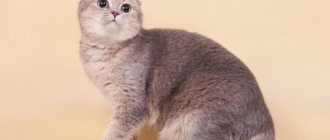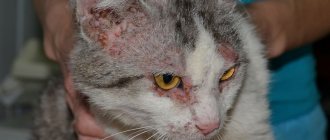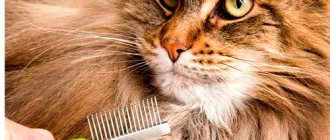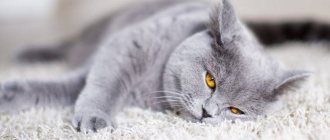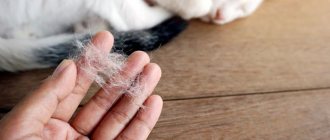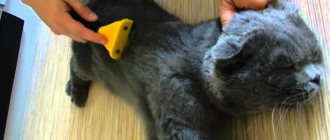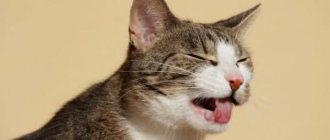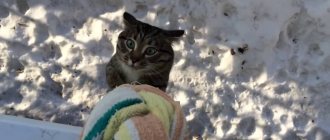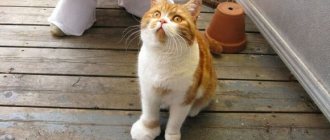Pet owners know firsthand that animals give positive emotions. But if you have a cat, caring for him sometimes requires more time. Problems can be different, for example, a small predator may start molting. And it is very important to know its reasons in order to quickly resolve the issue. There is nothing difficult in helping an animal if you pay due attention to it. In this article we will look at the causes of shedding and how to treat it.
What periods are considered normal for molting in terms of time of year and duration?
Seasonal coat change is a natural phenomenon that should not bother owners.
Cats shed their hair from time to time. The first hair change is called juvenile. A teenager changes his child's coat to an adult's one at six months of age, sometimes a little earlier or later.
Mature cats shed twice a year: in spring and autumn. This is how animals protect themselves from summer heat and winter frosts. This molting is called seasonal, or physiological.
The hair change process takes up to nine weeks. Shedding usually does not cause problems in pets of short-haired breeds. Long-haired cats need help from their owners. If you do not comb out the hair that falls out, tangles form, within which ideal conditions are created for the reproduction of ectoparasites.
Short-haired and long-haired
For a person who suffers from allergies or does not have the opportunity to often care for cat hair, an important condition for choosing a pet is seasonal shedding. Do not choose a cat with long hair and lush undercoat. The hairs of the cat's undercoat come out more abundantly than the guard hairs and settle on furniture and clothes. The optimal breed for an allergy sufferer is one with short hair and little undercoat or hairless.
Cats that shed frequently
Let's list which cat breeds have the most severe process of hair loss:
- British and Scottish cats shed all year round;
- Maine Coons, Siberian cats, and other long-haired breeds - they are characterized not only by seasonal shedding, but also by less intense hair loss throughout the year;
- Angoras, Somalis, Burmese, American Curls are also long-haired, but little hair falls out, long hairs are easily removed from furniture.
Cats that don't shed
Breeds of non-shedding cats that you don’t have to fuss with:
- Siamese, Oriental, Abyssinian, Bengal, Singaporean - these cats have no or short undercoat, so shedding takes place in a short time, and much less hair falls out;
- Sphynx cats;
- curly cats - laperm, rex.
Causes of severe shedding
Long-term intense hair loss is called pathological shedding.
It occurs for the following reasons:
- congenital anomalies;
- unbalanced diet;
- frequent bathing;
- stress;
- allergy;
- drug dermatitis;
- hormonal disorders;
- infectious diseases;
- oncology.
Congenital pathologies
With a genetic abnormality called hypotrichosis, the kitten's hair begins to fall out rapidly. By eighteen weeks the pet is completely hairless and remains that way for the rest of its life.
Also, a kitten may have a genetic predisposition to seborrhea or adenitis - hypersecretion of the sebaceous glands. An additional sign of the presence of one of these diseases is an unpleasant odor from your pet’s skin.
Unbalanced diet
Each cat has different nutritional needs. Some pets are not suitable for ready-made food, while others are not suitable for natural food. First, the fur stops shining, then it becomes disheveled and begins to fall out.
Be sure to read:
Why does a cat bite and gnaw its tail strongly, sometimes until it bleeds? Should I be worried?
Sometimes the cause of deficiency is a changed physiological state.
A lactating female requires a diet richer in healthy components. Nutrients are primarily used to maintain vital functions and synthesize milk. The hair does not receive enough of it and therefore dies.
Not only a deficiency, but also an excess of nutrients has an adverse effect. Thoughtless use of vitamin supplements leads to poisoning. The body gets rid of toxic metabolites through diarrhea, vomiting, increased urination and shedding hair.
Frequent bathing
Cats can, but don't like to swim. They don't need bathing. Often overly caring housewives regularly wash their pussy. The shampoo degreases the hairs, they lose their protective layer, become brittle, and fall out.
Stress
A change of environment, a long journey, fear, jealousy, or a sudden change in diet can cause an inadequate reaction. The cat develops baldness in certain areas, sometimes half of the body.
Allergy
Hair loss is a side effect of medication.
Your pet may have an allergic reaction to:
- feed components, such as chicken or cereal proteins;
- odors, perfumes, tobacco smoke, pollen, fungal spores - atopic dermatitis;
- household chemicals, accessories, flea collars - contact dermatitis.
Additional symptoms of allergies are rashes, crusts and ulcers.
Drug dermatitis
Hair loss is a side effect of medication use. The course of treatment is interrupted and the drug is replaced.
Hormonal disorders
The main cause of hormonal disorders is diseases of the endocrine glands or regular use of contraceptives: Contrasex, Anti-meow, etc.
Contagious diseases
Hair loss in most cases is accompanied by a violation of the integrity of the skin.
It is provoked by the following diseases:
- lichen - a fungal infection of the skin;
- flea dermatitis;
- notoedrosis, demodicosis - lesions by intradermal mites;
- helminthiasis - infection by parasites.
Oncology
Cancer affects all life support systems, including hair follicles. The onset of tumor formation usually coincides with the aging of the cat.
When do kittens start moulting?
Little kittens hardly shed; instead of fur they have baby fluff.
But caring for the fur of kittens should begin at a young age, as it will be much easier to accustom them to brushing.
However, caring for a kitten’s fur coat, and, in particular, brushing, must begin from an early age. It is much easier to train a small kitten to be groomed than an adult. Also, early brushing will help prepare them for their first shed.
It's easier to train a kitten to brush
Kittens begin to shed at about six months (5 – 8 months). Not only the fur changes, but also its color. When cats begin to shed for the first time, which can be up to 6 months, it is the most intense because the body is subject to a complex maturation process.
Ways to reduce shedding
To reduce the intensity of hair loss, the root cause is eliminated. Cats suffering from seborrhea and adenitis are treated during exacerbations with external means - aerosols or ointments, which are prescribed by a veterinarian.
Be sure to read:
Bald patches in a cat near the ears and above the eyes: reasons, what to do, how to distinguish normality from pathology
Hair loss from a lack of nutritional components is observed when feeding natural food, ready-made economy-class food. Some foods are not suitable for animals. Your veterinarian can advise you on which foods or supplements to use and which to avoid.
Sometimes hair loss stops if you stop bathing your pet frequently. When stressed, the fur grows back when the animal calms down. To do this, you need to play with your pet, pay attention to it, and pet it. They also use sedatives: Kot Bayun, Stop-stress, Feliway.
To treat infectious diseases, hormonal disorders, oncology and side effects of drugs, they seek veterinary help.
Long-haired pets are periodically combed.
Diagnosis of hair loss
Only a veterinarian can correctly determine the reason why your cat is shedding excessively. To do this, you will have to contact your veterinary clinic.
At the veterinary clinic, the veterinarian will give your cat:
- Clinical examination, during which the cat's skin, ears and mucous membranes will be carefully examined.
- He will collect a medical history from you (how the hair loss progressed, are there any additional symptoms of the disease that could cause hair loss in the cat).
- They will do blood tests (for hormones, to rule out allergies, infectious diseases).
- A scraping will be taken from the affected areas of the epidermis, followed by a microbiological examination of the hair follicles.
- If necessary, X-ray examination and ultrasound will be performed.
Based on the diagnostic studies performed, the cause of hair loss and severe shedding of your pet will be determined.
How to relieve a cat's condition
Hypotrichosis is incurable. The animal will constantly freeze. Therefore, it is necessary to maintain an optimal air temperature in the apartment - 22-24 °C. If the owners decide to walk the cat in cool weather, they will have to dress it.
Long-haired pets are periodically combed.
In long-haired pets, in addition to excessive shedding, intestinal blockage may occur with trichobezoars - stones formed from a mixture of hairs swallowed while licking and the contents of the alimentary tract.
If the cat owner does not use special super-premium food, you will have to periodically give Malt paste, which prevents hair from clumping.
To speed up molting, special feed additives are used:
- Laveta Super from Beafar;
- Sherstevit;
- Gimpet.
Products based on brewer's or feed yeast reduce the duration of shedding. Caring for a shedding pet involves frequently combing out lost hair.
In advanced situations, the crumpled wool is removed using tangle cutters. If the cause of hair loss is a contagious disease, you must follow the instructions of your veterinarian.
Why is it important to remove dead hair?
Villi that have already fallen out but are not removed from the cat’s body can cause irritation and itching on the animal’s skin. It actively licks off excess fur and tries to remove it with its paws.
This can be dangerous because when hairballs get into the stomach, gastrointestinal upset and intestinal obstruction begin.
Hair getting into the stomach leads to intestinal disorders and causes nausea
With its paws, a cat can scratch itself, which serves as a breeding ground for infections that cause skin diseases.
Wool flying around the house can cause allergies in allergy sufferers living in the house, especially in the spring.
Actions in case of pathological condition
First of all, pay attention to the well-being of the pet. If the cat feels normal, it is necessary to switch to super-premium hypoallergenic food.
The use of vitamin supplements along with natural food or economy-class food is dangerous.
An overdose will only increase shedding. If the cat feels unwell or changing food does not help, seek qualified help.
Be sure to read:
The cat scratched its neck until it bled: what to do, what to apply, how to treat it
Stress
Prolonged stress is a common cause of excessive hair loss. There are many stressful situations that lead to breakdown of the nervous system of unfortunate animals - from a long absence of a beloved owner to moving to a new home.
Food stress is possible when an animal’s diet changes dramatically or one food is replaced with another “without warning.”
What to do to prevent your cat from shedding in such situations?
- Give her more time and attention.
- Introduce new foods gradually.
Vitamins for cats
Cat owners have a choice: give imported complete food of premium class and higher or use natural food. In the first case, vitamins are not needed. They are included in the finished dry food in the required quantities and optimal ratio.
If the owner uses an unbalanced diet, the pet may develop problems with its coat. The problem is eliminated with the help of complex vitamin and mineral supplements.
Cat lovers prefer to use the following drugs:
- Felvit Multi;
- Kitty's +Taurine-Biotine;
- Gimpet Katzentabs;
- Laveta Super;
- Kitty's +Taurine-Biotine/Proteine/Cheese (vitamin mixture for cats);
- vitamins Doctor ZOO.
Flea dermatitis
This is the most common disease that is associated with allergic skin reactions to secretions secreted by fleas. Signs of the disease:
- The cat itches, licks itself, bites off fleas;
- The surfaces of the thighs and abdomen shed;
- There are bald patches with uneven borders that appear quickly and in large numbers;
- There are fleas on the animal's body or in the house.
You can diagnose an infestation by looking for fleas in the fur, but you can take your cat to the vet. The classic treatment option is treating the animal with flea substances and disinsection of the home. Furniture and cat litter require special attention.
Improper feeding
Since improper feeding almost always ends in hair loss for both cats and cats, it is worth recalling that a good appetite and abundantly filled bowls are not always an indicator of a proper diet. If the food of a cat, kitten, cat is not balanced and poor in the main indicators of fats-proteins-carbohydrates, then you can’t expect a normal appearance and structure of the coat.
© shutterstock
When choosing food, you need to take into account the gender, age, physical activity and general condition of the animal. Normalizing metabolism means stopping the shedding of a cat, cat or kitten!
Bathing
Frequent bathing unless necessary is unacceptable. Each cat’s “bath regime” is special, depending on many factors. But with intense shedding, it is recommended to wash the cat. Bathing will speed up the loss of old fur and free the skin from dirt. It is important to use special shampoos that do not irritate or dry out the animal’s skin. When selecting products, it is recommended to consult a veterinarian. So, for bathing kittens and adult cats, you can use “Gentle” shampoo, containing the natural component of aloe vera. It foams well, gently cleanses the coat and gives it shine.
Regular brushing
This procedure should ideally be daily. It is recommended not only for long-haired cats, but also for short-haired cats, to comb their fur coat during seasonal shedding. It is important to choose the right comb or brush. The frequency and size of the metal teeth must correspond to the parameters of the animal's coat. Puffers are not suitable for constant use; they must be used in very measured doses and carefully. If mats form, the cat will most likely need to be trimmed. You can try combing out small tangles using a special comb and Elite Professional spray. Animals with long fluffy hair may also need a hygienic haircut in the summer. But keep in mind - a haircut can affect the appearance of the coat, change its quality, and older cats will not be able to restore their coat in full.
